 Kyoto used to be the capital of Japan and the residence of the Emperor from 794 until the Meiji Restoration of 1868, when the capital was moved to Tokyo. During its millennium at the center of Japanese power, culture, tradition, and religion, it accumulated an unparalleled collection of palaces, temples and shrines, built for emperors, shoguns, and monks. Kyoto was among the few Japanese cities that escaped the allied bombings of World War II and as a result, Kyoto still has an abundance of prewar buildings, such as the traditional townhouses known as machiya.
Kyoto used to be the capital of Japan and the residence of the Emperor from 794 until the Meiji Restoration of 1868, when the capital was moved to Tokyo. During its millennium at the center of Japanese power, culture, tradition, and religion, it accumulated an unparalleled collection of palaces, temples and shrines, built for emperors, shoguns, and monks. Kyoto was among the few Japanese cities that escaped the allied bombings of World War II and as a result, Kyoto still has an abundance of prewar buildings, such as the traditional townhouses known as machiya.
Kyoto is now one of the most popular destinations for tourists, and carries a reputation as its most beautiful city. However, visitors may be surprised by how much work they will have to do to see Kyoto’s traditional beautiful side. Most first impressions of the city will be of the urban sprawl of central Kyoto, around the ultra-modern glass-and-steel train station, which is itself an example of a city steeped in tradition colliding with the modern world. 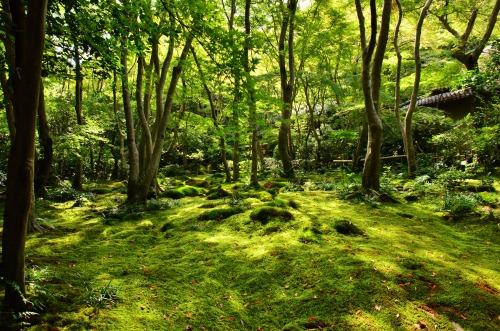
Nonetheless, the persistent visitor will soon discover Kyoto’s hidden beauty in the temples and parks which ring the city center, and find that the city has much more to offer than immediately meets the eye.
Though dwarfed in size by other major Japanese cities, Kyoto is vast in terms of its rich cultural heritage – the material endowment of over a thousand years as the country’s imperial capital. The city’s numerous palaces, shrines, temples and other landmarks are spread out over the following districts:
- Central – Site of Nijō Castle (a former residence of the Tokugawa shōguns) and the stately grounds of the Imperial Palace.
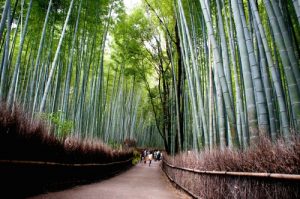
- Arashiyama (Western Kyoto) – Set against the beautiful tree-covered hills of Arashiyama, this district is rich in both historic and natural wonders.
- Higashiyama (Eastern Kyoto) – Nestled between the Kamo River and the temple-studded mountains of Higashiyama, this area’s many attractions include the famed geisha district of Gion and the historic sites strung alongside the well-known Philosopher’s Path.
- North – Graced with scores of centuries-old shrines and temples, including several World Heritage Sites. One of Kyoto’s most famous attractions – the magnificent gilded pavilion of Kinkaku-ji – can be found here.
- South – This district covers a large part of Japan’s former capital, stretching from the Ōharano area in the west to Fushimi-ku, Daigo, and the southern tip of Higashiyama-ku in the east.
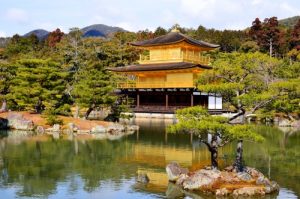 17 historic sites are inscribed on UNESCO’s World Heritage List under the group designation Historic Monuments of Ancient Kyoto. 14 of the listed sites are in Kyoto itself, two are in the neighboring cities.
17 historic sites are inscribed on UNESCO’s World Heritage List under the group designation Historic Monuments of Ancient Kyoto. 14 of the listed sites are in Kyoto itself, two are in the neighboring cities.
- Northern Kyoto: Kinkaku-ji, Ryōan-ji, Ninna-ji, Kōzan-ji, Shimogamo Shrine, Kamigamo Shrine
- Central Kyoto: Nijō Castle, Nishi Hongan-ji, Tō-ji
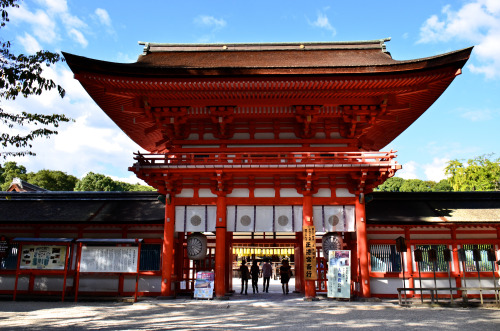
- Eastern Kyoto: Kiyomizu-dera, Ginkaku-ji
- Western Kyoto: Tenryū-ji, Koke-dera
- Southern Kyoto: Daigo-ji
Well-known for its abundance of historical sites, Kyoto often draws visitors eager to experience traditional Japanese culture. Buddhist meditation sessions are one of the most popular of these activities, and multiple options are available. Attending the Japanese tea ceremony (“the Way of Tea” or Cha-no-yu”) is also very popular for visitors from abroad.
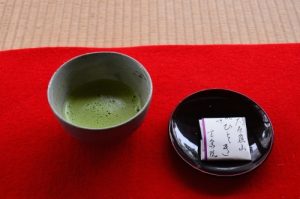 Other than sightseeing, Kyoto boasts a lot of specialities including Maccha(green tea), Yatsuhashi(kind of rice cake, both baked and raw), hamo (Japanese conger), tofu or Yu-dofu (try places around Nanzenji temple), vegetarian dishes (thanks to the abundance of temples), kaiseki-ryori (multi-course chef’s choice that can be extremely good and expensive), and Japanese Sake (Fushimi area of Southern Kyoto has a 400 year old brewery, Gekkeikan.)
Other than sightseeing, Kyoto boasts a lot of specialities including Maccha(green tea), Yatsuhashi(kind of rice cake, both baked and raw), hamo (Japanese conger), tofu or Yu-dofu (try places around Nanzenji temple), vegetarian dishes (thanks to the abundance of temples), kaiseki-ryori (multi-course chef’s choice that can be extremely good and expensive), and Japanese Sake (Fushimi area of Southern Kyoto has a 400 year old brewery, Gekkeikan.)
You have plenty of choices in buying souveniers when returning home; traditional Japanese sundry goods like fans and parasols, wooden dolls, incense, traditional sweets, potteries, etc., etc. A shopping paradise regarding range and quantity of choice.
Neighboring cities and towns are also full of attractive sightseeing spots.
- Uji – the best tea in Japan and the Byodo-in temple.

- Kurama – less than an hour’s journey by a local train from Kyoto Demachi-Yanagi station, the small village of Kurama has real onsen (Japanese natural hot springs). A nice mountain walk can be made to Kibune, where you can take the train back to Kyoto. The trail is broad and not dangerous, but it consists of many steps. The trip would take 90 minutes (if you don’t look too long to all temples and shrines along the route). A map can be obtained from tourist information in Kyoto station.
- Ohara – a beautiful rural area nestled in the mountains, one hour bus ride from Kyoto. Well known for Sanzen-in Temple.
- Hieizan(Mount. Hiei) – an ancient hilltop temple complex that traditionally guarded Kyoto.

- Hodukyo – a beautiful valley right next to Arashiyama. You can enjoy the scenery while rafting in the river, or riding a trolley train (open window train) without taking the trouble of walking.
- Osaka – half an hour from central Kyoto by Hankyu or Keihan railway or from Kyoto station by JR. This bustling city offers more retail opportunities and a central castle. With its longest and distinctive history of civil society, the city is still filled with democratic culture and delicious foods with the common touch.
 Kobe – a scenic port town famed for sophisticated patisseries, bakeries and cutting-edge fashion center. Might be most known for the annihilation in Great Hanshin Earthquake, but now shows a remarkable recovery. Night scene viewed from Mt. Maya, rated as best in Japan, would surely make a cherished memory.
Kobe – a scenic port town famed for sophisticated patisseries, bakeries and cutting-edge fashion center. Might be most known for the annihilation in Great Hanshin Earthquake, but now shows a remarkable recovery. Night scene viewed from Mt. Maya, rated as best in Japan, would surely make a cherished memory. 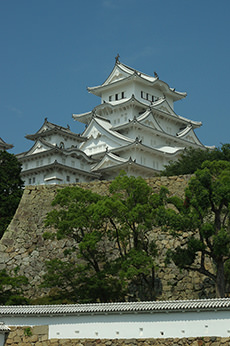 Himeji – about an hour by Shinkansen west of Kyoto. Spectacular traditional Himeji castle is now declared a World Heritage site.
Himeji – about an hour by Shinkansen west of Kyoto. Spectacular traditional Himeji castle is now declared a World Heritage site.- Nara – half hour journey by Kintetsu train from Kyoto station, Nara is an even older capital than Kyoto and has a stunning collection of temples in a giant landscaped park.
- Kouka(Kouga) – home of ninjas, and there is the Miho Museum. Neighboring Shigaraki is quite famous for pottery and porcelain.
- Amanohashidate – literally “the bridge to heaven”, it is considered one of Japan’s top three scenic views (along with Matsushima in Miyagi prefecture and Miyajima in Hiroshima prefecture). It forms a thin strip of land straddling the Miyazu Bay in northern Kyoto Prefecture, hence the name. Visitors are asked to turn their backs toward the view, bend over, and look at it between their legs.
Other useful info:
This page uses [Kyoto travel guide – Wikitravel](http://wikitravel.org/en/Kyoto) contents. So, the license of this contents is also [Creative Commons — Attribution-ShareAlike 3.0 Unported — CC BY-SA 3.0](https://creativecommons.org/licenses/by-sa/3.0/)
Photos of Kyoto by sanographix (http://photo.sanographix.net/)
